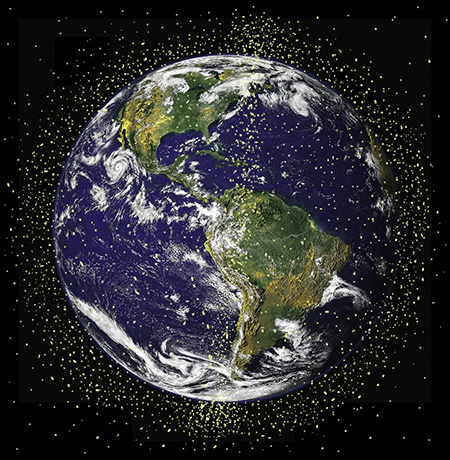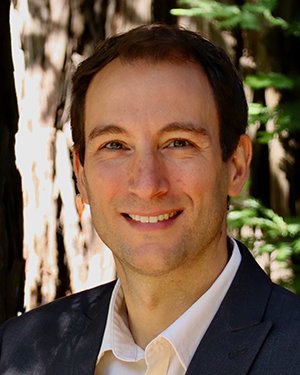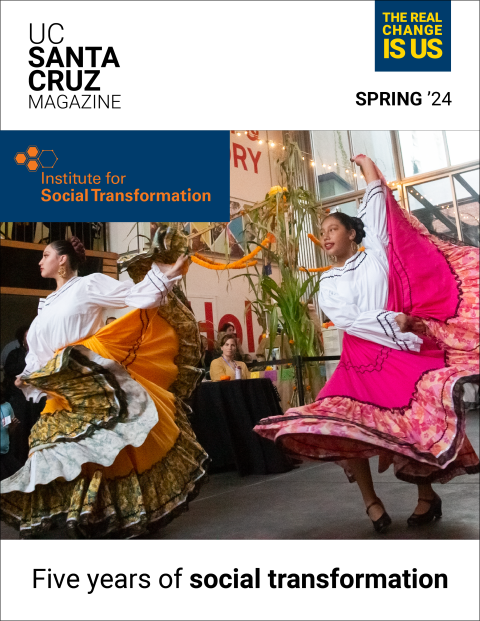Imagine Earth from space: a blue marble, a pristine orb that is our one and only home. But like many other places on the planet itself, this view is littered with the evidence of humans: in the earth’s orbit floats more than 30,000 individual pieces of space debris larger than 10 cm, according to a 2023 report from the European Space Agency.
A new project led by Ricardo Sanfelice, UC Santa Cruz Professor and Department Chair of Electrical and Computer Engineering, will develop technology for better spacecraft that use complex robotics to clean up space debris, as well as repair, refuel and decommission other spacecraft. A research team will create highly detailed “digital twin” models of spacecraft that can carry out these complex tasks in space and develop next-generation control algorithms to manipulate those models, enabling experimentation without the costs of testing on the physical system.
Sanfelice and his research team have been awarded $2.5 million from the Air Force Office of Scientific Research (AFOSR) Space University Research Initiative (SURI) for this three-year project. Co-principal investigators include UC Santa Cruz Professor of Applied Mathematics Daniele Venturi, UT Austin Professor of Aerospace Engineering Karen Wilcox, and University of Michigan Professor of Aerospace Engineering Ilya Kolmanovsk; and the team will collaborate with government and industry partners including the Air Force Research Lab Space Vehicles Directorate, The University of Arizona, Raytheon Technologies, Trusted Space, Inc., and Orbital Outpost X.
Developing digital twins
A digital twin is a computer model of a physical system, designed to perfectly mimic the properties of the real-world object, including all of the instruments, computers, sensors, surrounding environment, and anything else the system might include. Digital twins enable researchers to conduct experiments and run analysis in the digital world, testing what concepts might work in the real world to determine if they are worth building and manufacturing.
Unlike more traditional simulations, digital twins often incorporate machine learning that allows the system to improve itself through experimentations, providing valuable iteration to build a more accurate and detailed system.
Digital twins can be useful in a range of engineering disciplines, but are particularly relevant for aerospace engineering where the costs associated with building the real systems are so high.
“You can accelerate your production, you can reduce time and costs and risk of spacecraft design – because spacecraft technology is very expensive and requires a lot of certification and regulation before they can go into space,” Sanfelice said. “Rather than performing those experiments which take a lot of time in the real world, with a digital twin you can do conceptual analysis and initial validation in the computer environment. This same logic extends to other complex and costly systems — it’s all about scale and reduction of production time, cost, and risk while maintaining system performance and safety.”
Digital twins are also especially useful for aerospace engineering because they allow engineers to test complex scenarios and so-called “corner cases,” situations where multiple parameters are at their extreme, within the realm of the computer. Highly complex and extreme situations are more likely to occur in the harsh conditions of space, and can’t be fully replicated for experimentation back on Earth.
The models will enable the researchers to deeply examine what is necessary to carry out the highly complex tasks of clearing up space debris and using a spacecraft to refuel, repair, or demission other spacecraft. Such tasks could include a situation where a robotic arm on one spacecraft is trained to grab another spacecraft that is malfunctioning and tumbling through space, potentially damaging one or both of the systems. The researchers need to teach the computers to handle the tumbling and steering, developing optimization-based techniques to quickly compute and solve unexpected problems as they arise while also allowing for possible human intervention.
Modern methods of control
Sanfelice and his Hybrid Systems Lab will focus on developing the control algorithms that allow for experimentation on the spacecraft digital twins. The digital twin models need to be so complex to fully encapsulate the physics and computing variables of the real-world systems they represent, and this in turn requires new methods to control the models that go beyond the current state-of-the-art.
“I have this massive detailed model of my system, it keeps updating as the system evolves and I run experiments – can I write an algorithm that makes the digital twin do what I want it to do, and as a consequence hopefully the real physical system will do the same?” Sanfelice said.
Sanfelice’s work will center around developing model predictive control algorithms, a type of optimization-based control scheme, to control the digital twins, of which Wilcox will lead the creation. Sanfelice’s lab develops robotic manipulators for grasping and other tasks performed by robotics, which require hybrid control schemes to enable the robotic fingers to be able to transition between conditions of contact and no contact with the object they are manipulating.
While the model predictive control techniques they develop for this project will be highly relevant to aerospace applications, Sanfelice believes there is an opportunity to expand to other complex application areas and develop more advanced basic science for digital twins and their control.
‘Digital twins’ project will help clean up space junk, repair and decommission spacecrafts
Ricardo Sanfelice and a team of researchers have been awarded $2.5M to model complex aerospace engineering problems




